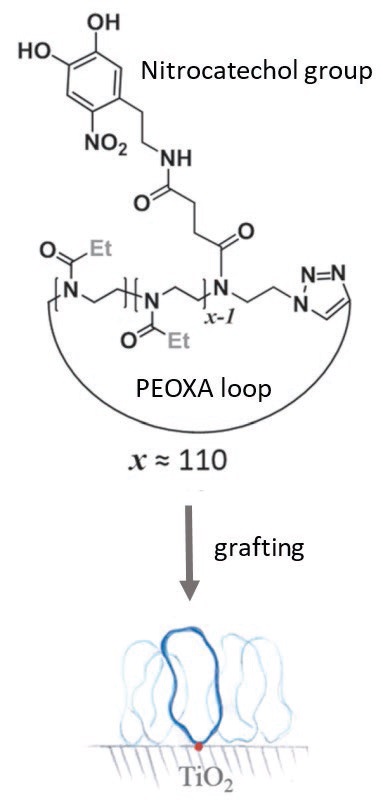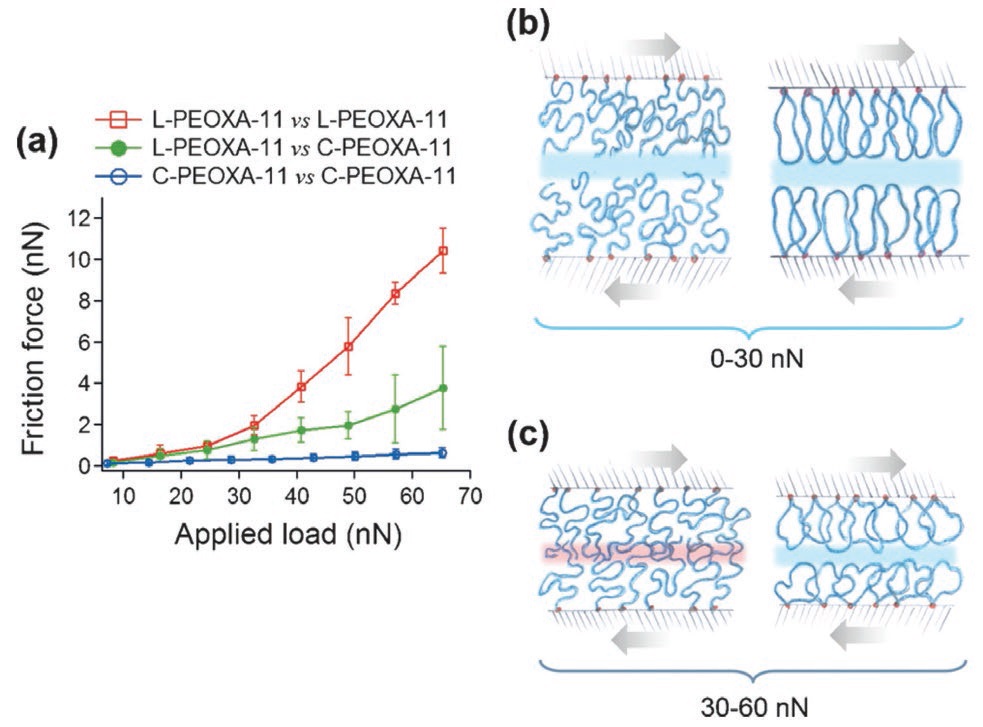Lubricating with loops
Drs. Wilfred T. Tysoe & Nicholas D. Spencer | TLT Cutting Edge December 2017
Polymer brushes make surfaces lubricious, but carpets of cyclic polymers do the job better!
WE HAVE WRITTEN PREVIOUSLY about the ability of end-grafted, closely spaced, solvent-swollen polymer chains to form highly lubricious surfaces, especially when rubbed against each other (
1). Such systems, known as polymer brushes, have such important functions as (a.) holding the solid surfaces that support them apart, thus preventing asperity-asperity contact, (b.) forming an elastic cushion between the sliding surfaces due to the osmotic pressure that is contained within them and (c.) providing a fluid film between the brushes, even in the absence of any sliding velocity, to form a low-shear-strength sliding plane (
2).
While large-scale industrial applications of such systems have yet to be put into practice, they already are being applied in a number of clinical applications requiring very low friction, such as contact lenses and catheters. In these situations, low loads and short overall sliding distances are ideal for brush-based lubrication.
At low loads, overlapping between opposing polymer brushes is resisted by an entropic effect, but one of the disadvantages of current brush systems is that at higher loads the polymer chains have a tendency to interdigitate, leading to an increase in friction. A novel approach that seems much more resistant to this effect has been developed by Dr. Edmondo M. Benetti with his colleagues Giulia Morgese, Lucca Trachsel, Matteo Romio, Moh Divandari and Shivaprakash Ramakrishna at the ETH Zurich (Swiss Federal Institute of Technology) in Switzerland (
3).
Benetti and coworkers synthesized a novel polymer topology that they grafted onto surfaces with a high density. The polymer consisted of cyclic poly-2-ethyl-2-oxazoline (PEOXA,
see Figure 1) consisting of a loop of 110 units with an attached chemical anchor, nitrocatechol. Using a specially designed grafting procedure, they were able to attach an array of these cycles on a titanium oxide surface, rather like the loops that make up the surface of a carpet.
 Figure 1. A cyclic PEOXA adsorbate of 110 units with an attached nitrocatechol binding group can be readily attached in high density to a titania substrate. (Adapted from Reference 3 by kind permission. Figure courtesy of Wiley.)
Figure 1. A cyclic PEOXA adsorbate of 110 units with an attached nitrocatechol binding group can be readily attached in high density to a titania substrate. (Adapted from Reference 3 by kind permission. Figure courtesy of Wiley.)
Measurements with an atomic force microscope (AFM) showed that the cyclic grafts were much more resistant to indentation (i.e., showed a higher elastic modulus) than that of a corresponding brush of linear chains. The most interesting tribological property, however, was observed when using colloidal-probe lateral force microscopy to measure the friction between the carpet of cycles and a microsphere, also covered with ring polymers. Not only was the friction extremely low (µ ≈ 0.007) at low loads, but it remained low as the load was increased to values at which the friction for corresponding linear brushes would have already reached µ = 0.2 (
see Figure 2).
 Figure 2. (a.) Friction-load profiles recorded by colloidal-probe lateral force microscopy, shearing PEOXA brush-functionalized colloids against PEOXA brushes on flat substrates. (b.) At relatively low applied loads, cyclic-versus-cyclic brush tribo-pairs show low friction. (c.) Above 30 nN of applied force, interdigitation between two linear brush-bearing surfaces causes a steady increase of friction, whereas cyclic brushes do not interact due to the absence of chain ends and maintain low friction. (From Reference 3 by kind permission. Figure courtesy of Wiley.)
Figure 2. (a.) Friction-load profiles recorded by colloidal-probe lateral force microscopy, shearing PEOXA brush-functionalized colloids against PEOXA brushes on flat substrates. (b.) At relatively low applied loads, cyclic-versus-cyclic brush tribo-pairs show low friction. (c.) Above 30 nN of applied force, interdigitation between two linear brush-bearing surfaces causes a steady increase of friction, whereas cyclic brushes do not interact due to the absence of chain ends and maintain low friction. (From Reference 3 by kind permission. Figure courtesy of Wiley.)
It is well known that polymers on surfaces show interesting and potentially commercially useful friction-reducing properties, but it now seems that the topology of the polymer chains itself can play a crucial role in their lubricious properties and, thus, in their potential applicability in more severe, high-load conditions.
FOR FURTHER READING
1.
Tysoe, W.T. and Spencer, N.D. (2004), “Water: From Chicken Stock to Base Stock,” TLT,
60, p. 64.
2.
Spencer, N.D. (2014), “Aqueous Lubrication with Poly(Ethylene Glycol) Brushes,”
Tribology Online,
9(4), pp. 143-153.
3.
Morgese, G., Trachsel, L., Romio, M., Divandari, M., Ramakrishna, S. N. and Benetti, E. M. (2016), “Topological Polymer Chemistry Enters Surface Science: Linear versus Cyclic Polymer Brushes,”
Angewandte Chemie,
128(50), pp. 15812-15817.
 Eddy Tysoe (
Eddy Tysoe (left
) is a distinguished professor of physical chemistry at the University of Wisconsin-Milwaukee. You can reach him at wtt@uwm.edu.
Nic Spencer (right
) is professor of surface science and technology at the ETH Zurich, Switzerland, and editor-in-chief of STLE-affiliated Tribology Letters journal. You can reach him at nspencer@ethz.ch.